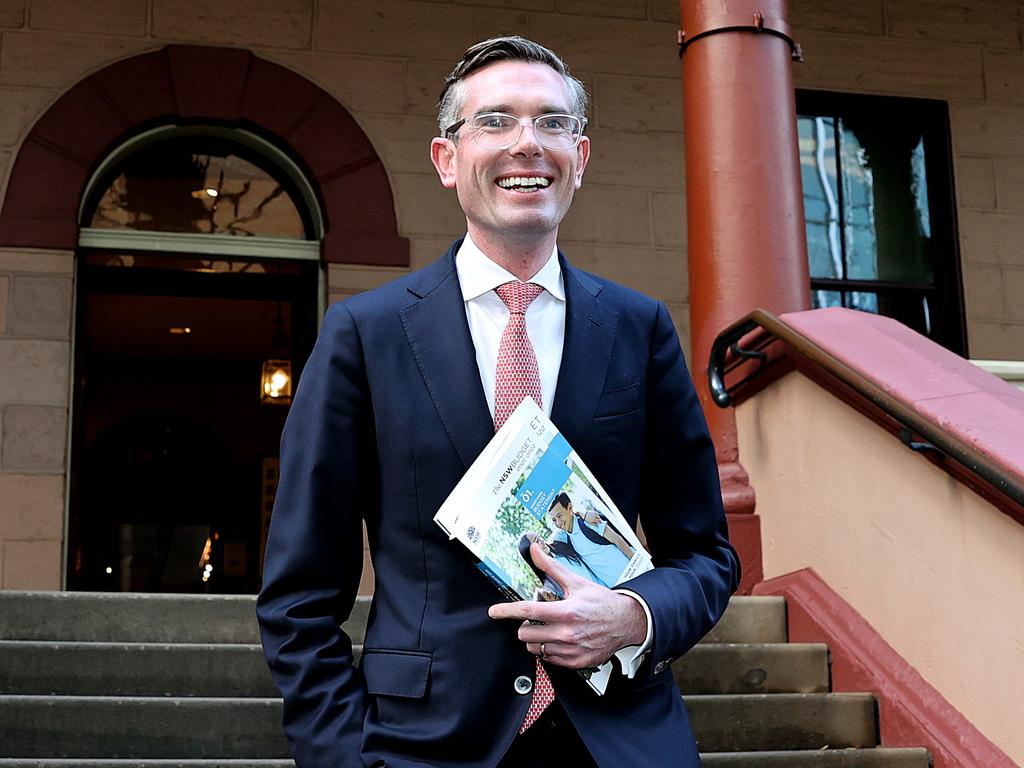NSW budget: State stages dramatic economic recovery
A booming Sydney property market and a turnaround in unemployment rates have seen NSW stage a dramatic Covid recovery.

A booming Sydney property market and a spectacular turnaround in unemployment rates have seen NSW stage a dramatic recovery from the COVID-19 pandemic, slashing its previous catastrophic debt forecasts as it claws back a budget surplus by 2025.
Seven months after delivering a pandemic budget filled with dire predictions and crisis measures to insulate the state from disaster, Treasurer Dominic Perrottet on Tuesday said economic activity had defied expectations and had not only returned to its pre-Covid levels but exceeded it.
Household spending has rebounded by 15 per cent since the depths of the downturn, business confidence has reached record highs, and every job lost as a result of the pandemic had been restored — along with 36,000 additional positions. Dwelling investments, which drove a sharp rise in stamp duty collections, had jumped 18 per cent.
But the budget papers also carry a cautionary warning that its optimistic visions would depend on the stability of the housing market, the reopening of international borders by mid-2022, and that jobs growth would continue through remote working trends borne out of the pandemic.
“We are back to growth, and back on track – and it is no accident,” Mr Perrottet said, crediting the government’s stimulus measures and its “gold-standard” health system with accelerating the state’s recovery.
“Today, other governments are raising taxes and cutting wages, sacrificing growth to save their budgets. In NSW we do not have to make that choice.”
Previously, unemployment had been forecast to hit 6.5 per cent during 2020-21 and 5.24 per cent by 2023-24. Those numbers have now been revised down significantly to hit 4.75 per cent in 2023-24 and 4.5 per cent – or full employment – the following year.
“We believe this state is on the pathway to success,” Mr Perrottet said.
GST receipts, stamp duty, payroll and land taxes have all helped fuel the recovery, forcing treasury officials to rewrite a slew of recent forecasts for the state’s debt and deficit positions.
As recently as November, debt levels were forecast to reach $104bn by 2023-24, a number now expected to drop to $94.3 billion. The budget papers say these debt levels will be reduced further by 2030 through measures that include “asset recycling”, a term used to describe the privatisation of state-owned assets.
The deficit – predicted to hit $16bn in 2020-21 – has been halved to $7.8bn, but will increase to $8.6bn next year as a result of further stimulus and spending measures to “protect the safety of our citizens”.
Mr Perrottet told reporters he could have returned the budget to surplus sooner but decided to use the available funding to raise the wages of public sector workers, along with other initiatives designed to boost the economy.
Efforts to control this expenditure will be introduced in coming years to bring down the deficit to $306 million by 2023-24, before the budget returns to an expected surplus of $466 million the following year.
Coming to the rescue has undoubtedly been the roaring Sydney property market, which has seen house prices surge by 20 per cent since the start of the pandemic and gifted the government a sharp increase in stamp duty intakes.
Stamp duty has been forecast to return $4.1 billion to the government until 2022-23 before these numbers retreat to $1.7bn over the remaining forward estimates through an expected cooling of the market.
“Annual house price growth is expected to peak around late 2021,” the budget papers say. “As higher prices encourage more owners to sell, this will work to limit house price growth over time.”
The state’s NSW Generations Fund, previously forecast to reach $70bn by 2030, is also in line to hit $90bn over the same period, with Mr Perrottet saying he would introduce legislation to ensure any drawdowns, by any government, would have to be reported to parliament.
The turnaround in the state’s fortune has seen a raft of spending announcements unveiled in recent weeks, including a $500 million package to promote the uptake of electric vehicles, a $2.7bn policy to increase public sector salaries that were frozen during the pandemic, and $3.3bn to provide construction stimulus and jobs across the state.
The Australian revealed on Tuesday that the NSW government would become the first in the nation to introduce paid bereavement leave for women who experience a miscarriage, a stillbirth, or a prematurely-born baby.
Funding has also been provided to upgrade palliative care facilities, school buildings, iconic walkways in national parks, an increase to the number of local court magistrates, and a boost to Aboriginal housing and infrastructure.
And, in one of the few budget sweeteners that have not already been publicised, Mr Perrottet said the government would spend $43.9 million providing a $100 Learn to Swim voucher to preschoolers aged between three and six, to develop water safety and swimming skills.







To join the conversation, please log in. Don't have an account? Register
Join the conversation, you are commenting as Logout